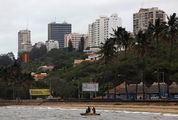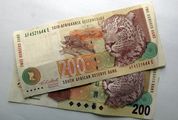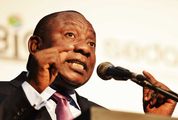ECONOMIC WEEK AHEAD: SA may skirt recession, but hold the bubbly
by Claire Bisseker,
2015-11-23 05:59:00.0
SA WILL narrowly avoid a recession in the third quarter, gross domestic product (GDP) figures out this week should confirm. But there will be little cause for cheer. Other data due out this week should show the economy continues to deteriorate.
Last week, the South African Reserve Bank indicated that SA would avoid entering into a recession, but warned that the economy remained weak.
It again revised down its GDP forecast for the year — albeit marginally, to 1.4% this year (from 1.5% previously) and to 1.5% next year (from 1.6%).
The consensus is that the economy grew at a tepid 1% quarter-on-quarter seasonally adjusted and annualised rate in the third quarter, following a 1.3% (quarter-on-quarter) contraction in the previous quarter. GDP data for the third quarter will be released by Statistics SA on Tuesday.
Both the mining and agricultural sectors appear to have contracted further in the third quarter as a result of falling commodity prices and the continuing drought in SA.
Growth was probably supported by a positive contribution from manufacturing and stronger growth in the wholesale and retail sectors, the latter thanks partly to robust public sector wage increases, said BNP Paribas Securities economist, Jeff Schultz.
The outlook for the manufacturing sector remains fairly bleak, however, judging from the Barclays Purchasing Managers index, which declined further in October. It has been below the neutral level of 50 for three consecutive months.
Also on Tuesday, the Bank will release its composite leading business cycle indicator for September. It declined in August for the fourth month in a row to 92.7 index points, having started the year at 95.8.
Further weakness is expected in the data as indicative of an economy in stagnation.
The Bureau for Economic Research will release its fourth quarter business confidence index on Wednesday. "In the absence of any meaningful improvement in domestic or global economic conditions, we would expect the index to have remained well below its neutral level of 50 after it slipped to 38 in the third quarter," Mr Schultz said.
"This should continue to bode ill for private fixed investment prospects over the medium term, entrenching the growth malaise that the economy currently finds itself in."
On Thursday, Statistics SA will release the producer price index for October.
Producer price inflation for final manufactured goods increased from 3.4% in August to 3.6% year-on-year in September.
The main pressure came from food, beverages and tobacco products, which contributed two percentage points to the total.
The increased intensity of the drought, which has led to downward revisions of the domestic maize crop estimate and sharp increases in maize and cereal prices, suggests that a further acceleration in food price inflation is likely.
This should sustain the upward trend in both the producer price index and consumer inflation in the coming months, according to the Bank. The Bank has flagged worsening drought conditions and the knock-on effect on food prices as one of the key risks to SA’s inflation outlook.
The other key risks are a marked depreciation of the rand and the possibility of additional electricity tariff adjustments. As a result of these mounting risks, the Bank raised the repo rate 25 basis points last week to 6.25%.

Picture: THINKSTOCK
SA WILL narrowly avoid a recession in the third quarter, gross domestic product (GDP) figures out this week should confirm. But there will be little cause for cheer. Other data due out this week should show the economy continues to deteriorate.
Last week, the South African Reserve Bank indicated that SA would avoid entering into a recession, but warned that the economy remained weak.
It again revised down its GDP forecast for the year — albeit marginally, to 1.4% this year (from 1.5% previously) and to 1.5% next year (from 1.6%).
The consensus is that the economy grew at a tepid 1% quarter-on-quarter seasonally adjusted and annualised rate in the third quarter, following a 1.3% (quarter-on-quarter) contraction in the previous quarter. GDP data for the third quarter will be released by Statistics SA on Tuesday.
Both the mining and agricultural sectors appear to have contracted further in the third quarter as a result of falling commodity prices and the continuing drought in SA.
Growth was probably supported by a positive contribution from manufacturing and stronger growth in the wholesale and retail sectors, the latter thanks partly to robust public sector wage increases, said BNP Paribas Securities economist, Jeff Schultz.
The outlook for the manufacturing sector remains fairly bleak, however, judging from the Barclays Purchasing Managers index, which declined further in October. It has been below the neutral level of 50 for three consecutive months.
Also on Tuesday, the Bank will release its composite leading business cycle indicator for September. It declined in August for the fourth month in a row to 92.7 index points, having started the year at 95.8.
Further weakness is expected in the data as indicative of an economy in stagnation.
The Bureau for Economic Research will release its fourth quarter business confidence index on Wednesday. "In the absence of any meaningful improvement in domestic or global economic conditions, we would expect the index to have remained well below its neutral level of 50 after it slipped to 38 in the third quarter," Mr Schultz said.
"This should continue to bode ill for private fixed investment prospects over the medium term, entrenching the growth malaise that the economy currently finds itself in."
On Thursday, Statistics SA will release the producer price index for October.
Producer price inflation for final manufactured goods increased from 3.4% in August to 3.6% year-on-year in September.
The main pressure came from food, beverages and tobacco products, which contributed two percentage points to the total.
The increased intensity of the drought, which has led to downward revisions of the domestic maize crop estimate and sharp increases in maize and cereal prices, suggests that a further acceleration in food price inflation is likely.
This should sustain the upward trend in both the producer price index and consumer inflation in the coming months, according to the Bank. The Bank has flagged worsening drought conditions and the knock-on effect on food prices as one of the key risks to SA’s inflation outlook.
The other key risks are a marked depreciation of the rand and the possibility of additional electricity tariff adjustments. As a result of these mounting risks, the Bank raised the repo rate 25 basis points last week to 6.25%.























Change: 1.37%
Change: 1.32%
Change: 2.91%
Change: 0.45%
Change: 3.09%
Data supplied by Profile Data
Change: 1.63%
Change: 0.83%
Change: 1.37%
Change: 0.00%
Change: 0.69%
Data supplied by Profile Data
Change: -2.04%
Change: -1.81%
Change: -1.61%
Change: -1.86%
Change: -1.48%
Data supplied by Profile Data
Change: -1.21%
Change: 0.31%
Change: -0.72%
Change: -1.39%
Change: 2.92%
Data supplied by Profile Data